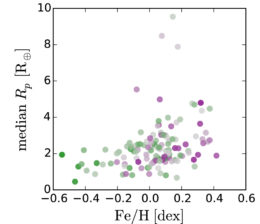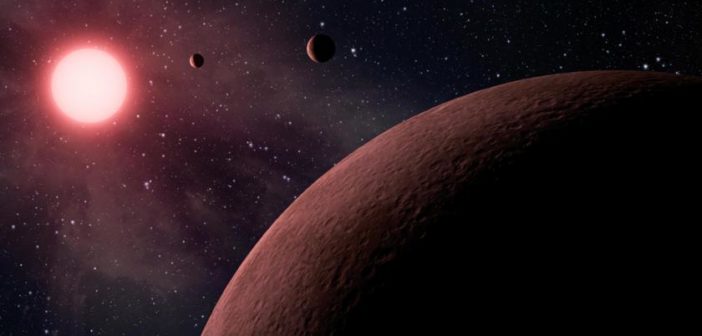After 8.5 years of observations with the Kepler space observatory, we’ve discovered a large number of close-in, tightly-spaced, multiple-planet systems orbiting distant stars. In the process, we’ve learned a lot about the properties about these systems — and discovered some unexpected behavior. A new study explores one of the properties that have surprised us: planets of the same size tend to live together.

Orbital architectures for 25 of the authors’ multiplanet systems. The dots are sized according to the planets’ relative radii and colored according to mass. Planets of similar sizes and masses tend to live together in the same system. [Millholland et al. 2017]
Ordering of Systems
From Kepler’s observations of extrasolar multiplanet systems, we have seen that the sizes of planets in a given system aren’t completely random. Systems that contain a large planet, for example, are more likely to contain additional large planets rather than additional planets of random size. So though there is a large spread in the radii we’ve observed for transiting exoplanets, the spread within any given multiplanet system tends to be much smaller.
This odd behavior has led us to ask whether this clustering occurs not just for radius, but also for mass. Since the multiplanet systems discovered by Kepler most often contain super-Earths and mini-Neptunes, which have an extremely large spread in densities, the fact that two such planets have similar radii does not guarantee that they have similar masses.
If planets don’t cluster in mass within a system, this would raise the question of why planets coordinate only their radii within a given system. If they do cluster in mass, it implies that planets within the same system tend to have similar densities, potentially allowing us to predict the sizes and masses of planets we might find in a given system.
Insight into Masses
Led by NSF graduate research fellow Sarah Millholland, a team of scientists at Yale University used recently determined masses for planets in 37 Kepler multiplanet systems to explore this question of whether exoplanets in a multiplanet system are more likely to have similar masses rather than random ones.
Millholland and collaborators find that the masses do show the same clustering trend as radii in multiplanet systems — i.e., sibling planets in the same system tend to have both masses and radii that are more similar than if the system were randomly assembled from the total population of planets we’ve observed. Furthermore, the masses and radii tend to be ordered within a system when the planets are ranked by their periods.

The host star’s metallicity is correlated with the median planetary radius for a system. [Adapted from Millholland et al. 2017]
- The scatter in the relation between mass and radius of observed exoplanets is primarily due to system-to-system variability, rather than the variability within each system.
- Knowing the properties of a star and its primordial protoplanetary disk might allow us to predict the outcome of the planet formation process for the system.
Following up on the second point, the authors test whether certain properties of the host star correlate with properties of the planets. They find that the stellar mass and metallicity have a significant effect on the planet properties and the structure of the system.
Continuing to explore multiplanet systems like these appears to be an excellent path forward for understanding the hidden order in the broad variety of exoplanets we’ve observed.
Citation
Sarah Millholland et al 2017 ApJL 849 L33. doi:10.3847/2041-8213/aa9714
